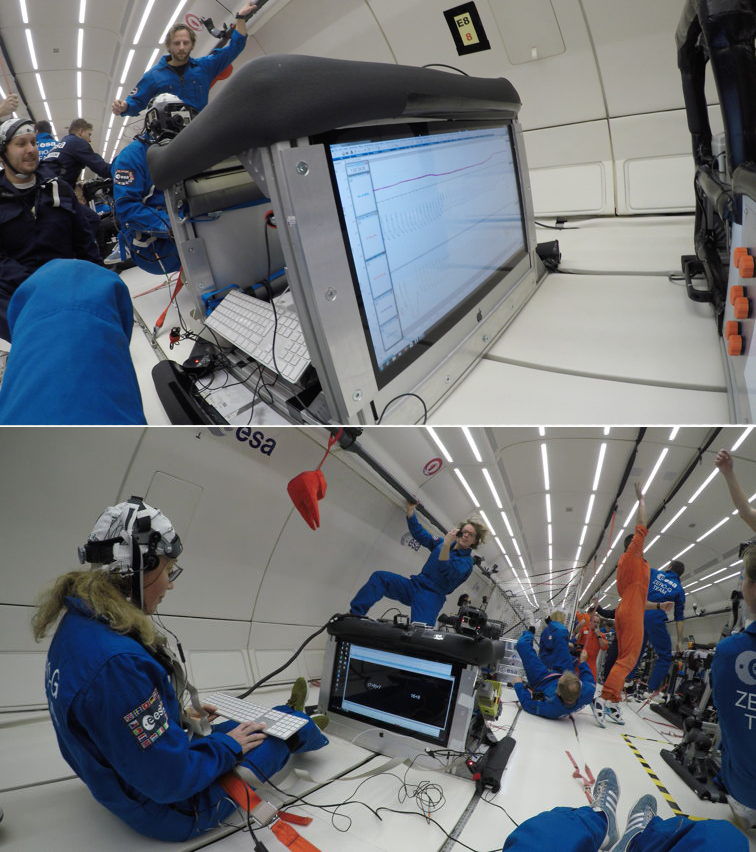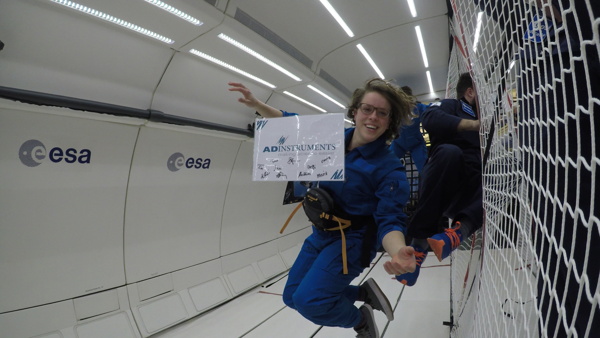PowerLab and LabChart are being used on special flights that simulate a zero-gravity environment, to help understand how our brains work in space.
Researcher Timo Klein talks about using PowerLab and LabChart for parabolic flight research.
German exercise physiology researcher Timo Klein is part of a team from the Institute of Movement and Neurosciences at the German Sport University, Cologne, and the University of the Sunshine Coast, Australia.
The team is using ADInstruments’ PowerLab hardware and LabChart software for data synchronization in the parabolic flight study, commissioned by the European Space Agency. The aim of the study is to find out why the human brain seems to work better in microgravity.
“We (Wollseiffen et al. 2017, Physiology & Behavior) have recently shown that cognitive function is improved during weightlessness, but we don’t know the exact reason why that is yet.” Timo Klein says. “So, one thing we are looking at in this study is whether it is a change in blood flow within the brain that causes this improvement.”
Using PowerLab and LabChart
To gather data for the research, the team uses an 8-channel PowerLab fitted into a rack inside a customized Airbus A-310. Timo says, “Every piece of equipment needs to be tied down for safety in zero gravity. The PowerLab is small and portable but can also collect all the different physiological signals we need.” LabChart 8 Pro software is also installed to analyze the data signals and runs continually throughout the flight.

LabChart and PowerLab in use during the flight
During the flight, study subjects wear an electroencephalography (EEG) cap that measures their brain cortical activity. Simultaneously, brain blood flow velocity is measured via transcranial Doppler ultrasound. Subjects also wear a finger cuff that records blood pressure. All of this information is sent to the PowerLab during the flight and is then analyzed using LabChart software. “LabChart lets us easily compare the different signals and time align them. Time aligning the signals simply wouldn't have been possible without Powerlab and LabChart" Timo says.
Preparing for the Flight
Since 1999 the German Aerospace Center (DLR) has run a regular flight programme that offers a set number of parabolic flights dedicated to scientific experiments and to space equipment technological testing each year, and funds numerous parabolic flight research projects from the German Sport University.
Around a dozen research teams and their subjects spend 2 weeks at a specialized facility in Bordeaux, France, preparing themselves and their experiments for the 3-hour parabolic flight.
"In the first week, we put all of our research equipment on the plane and it all gets checked and rechecked for safety. Everything is tethered down. We need to make sure we have everything we need for the experiments because once you are up on the flight there's no turning back - you can't have forgotten anything!" Timo says. “It’s taken one and a half years of planning for this flight, so it is vital that we have all our equipment and that it works without question.”
"In the second week the participants are briefed a lot on safety - and safety is of the utmost importance. We have astronauts talk to us about what it is like to be in zero gravity because a lot of the research subjects aren't sure what to expect. Many experiments call for a person who has never experienced weightlessness before" Timo explains.
Each parabolic flight carries around 40 people: the subjects and 'operators' involved in the different projects. Timo says, "On our flight, there were researchers involved in a wide range of disciplines, from botany to neuroscience."
At one end of the aircraft, there are 45 seats for participants. The rest of the aircraft's interior - a large space of around 100 square meters - is completely padded. This is where the experiments are set up and where the research teams conduct their experiments during the flights.

During microgravity (Marit Sanders)
The Parabolic Flight and Microgravity
During the flight, the pilots fly special maneuvers called parabolas, which are repeated sets of figure eights that simulate a microgravity environment. After taking off from Bordeaux-Merignac Airport, France, the Airbus A-310 climbs to a stable level flight altitude. The start and end of the flight are the same as a usual commercial airline flight. But at 20,000 feet up in the air, the flight takes on a very unusual trajectory.
First, the pilot pulls back hard on his controls, thrusting the aircraft into a steep 45-degree climb. Then the pilot cuts the engines. The plane’s momentum keeps it soaring upwards until its ascent slows and stops... and the plane begins to drop out of the sky. In this "free falling" phase, everything inside the aircraft goes into microgravity.
"It is quite tense as we are going up, and the subjects don't know what to expect. But as soon as we go into zero gravity, they are like little kids! It's amazing!" Timo says.
After about 20 seconds of falling, the pilot brings back the power and pulls out of the dive. And then he does it all again and again and again. Over the course of the 3-hour flight, the teams experience more than 30 of these parabolas, each with a short 20-second window of microgravity in which to gather their data.
"It's very precious time," Timo says. With only seconds to perform the research each round, it is vital that the research equipment is reliable and functions well. “We’ve been really happy with the quality and reliability of the PowerLab. It runs perfectly and we are collecting promising data" Timo says. "And LabChart is ideal in this situation because it lets us compare such a wide variety of data signals at once.”
Outcomes
Parabolic flights allow researchers to conduct experiments that relate to space travel and gravitational environments that are different from ours on earth. But the research doesn’t just have applications for astronauts. “We are interested in how the information about brain blood flow and its effect on cognitive function relates to studies of Alzheimer’s disease and dementia," Timo says. "If we know the underlying mechanisms which are linked to a change in cognitive performance and brain activity, and where that comes from, we might be able to better design strategies - for example, exercise programs - to help these people.”
Already, the team has observed that brain blood flow does change and responds quickly to the change in gravitational environment. The team will now return to Germany to further analyze their findings.
The team will use the same combination of PowerLab and LabChart for data acquisition and analysis for further parabolic flights this year when they will conduct experiments during flights which replicate the gravity of Mars and the moon.
